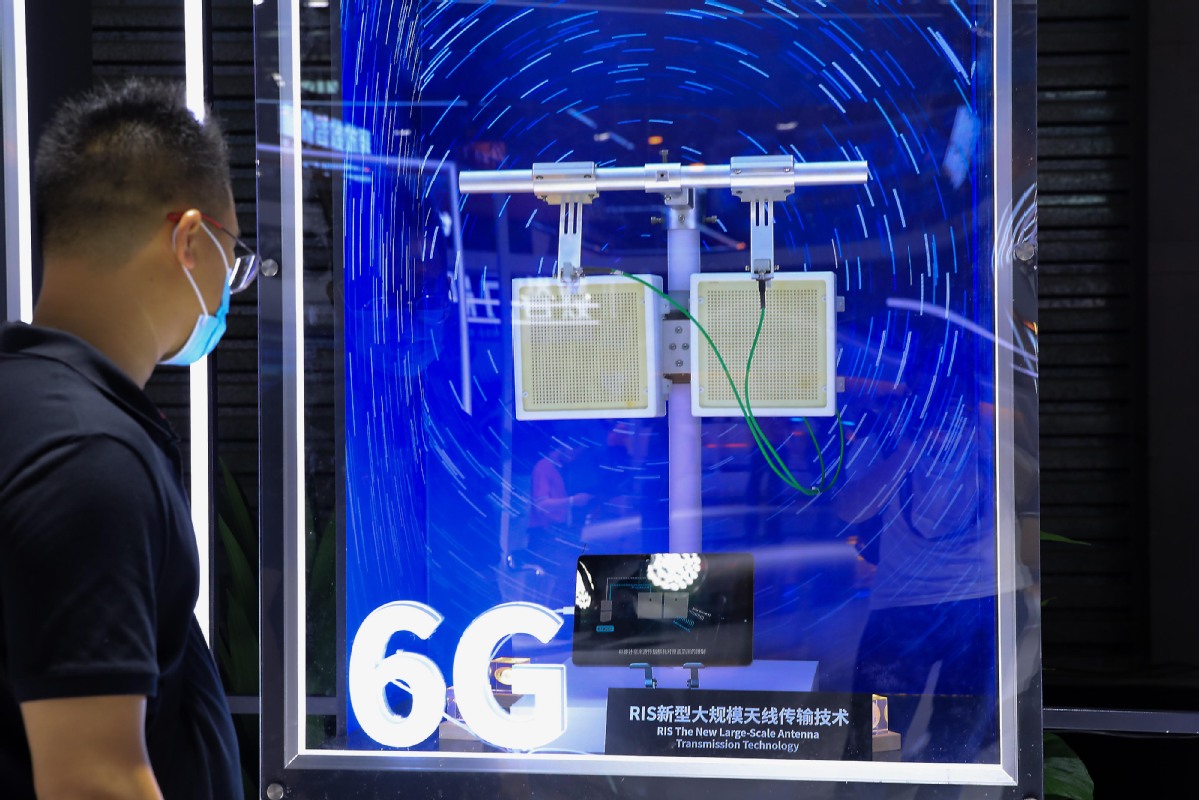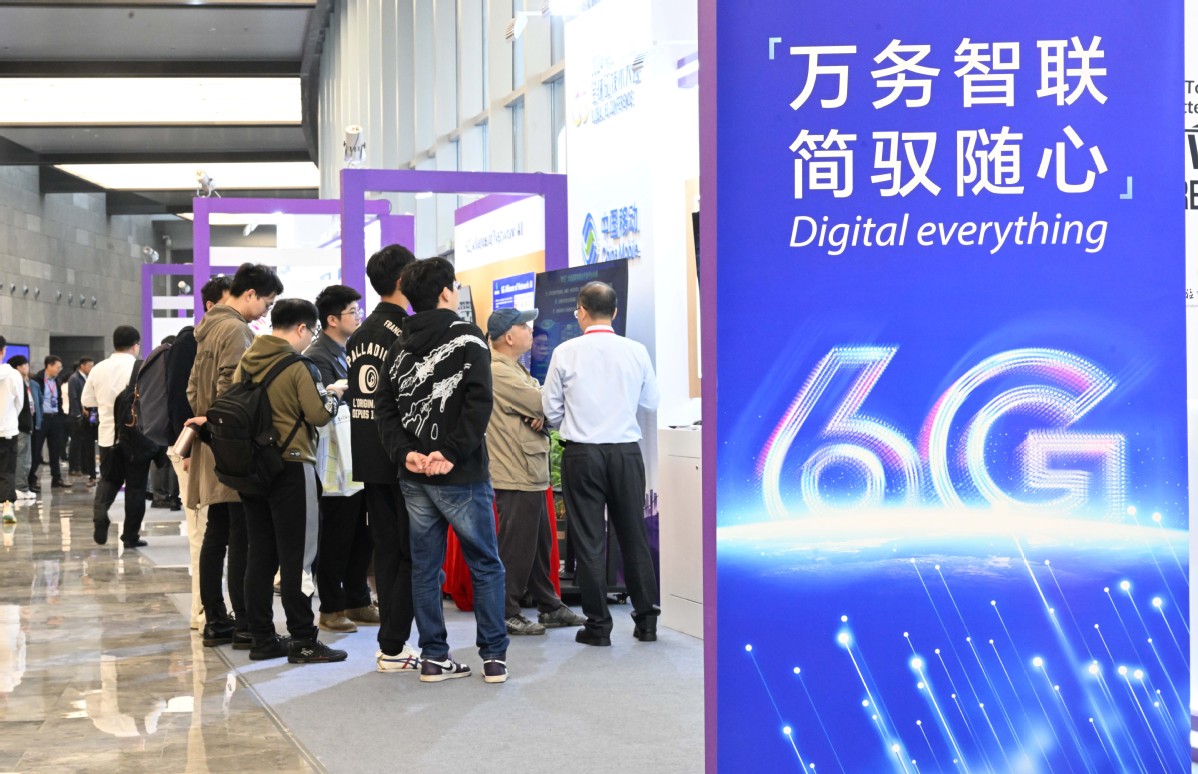Nation aims for beachhead in 6G development battle

Visitors wait in line to try AR glasses at the XREAL booth at the 2023 MWC. CHINA DAILY
Chinese academic researchers and telecom operators are leaving no stone unturned in efforts to establish a beachhead for 6G, the next-generation wireless technology that has already turned into a key battleground for innovation and industrial transformation.
Despite growing geopolitical interference in the global telecom industry, China has a solid foundation in telecom talent and patents, and its edge in 5G will help the country gain an upper hand in the race toward 6G research and development, experts and company executives said.
The comments came as the world enters a crucial window of opportunity to identify technologies and formulate key standards for 6G. While there is still no universally accepted definition of the technology, 6G is expected to have far lower latency, higher speeds and more bandwidth than 5G.
More importantly, the technology will be able to support the integration of space, air, territorial and maritime communication technologies, which will spawn a wide range of innovative applications, they added.
China is aiming to commercialize the technology around 2030. "We will kick off a string of scientific projects targeting 6G and aim to achieve breakthroughs in crucial technologies," said Jin Zhuanglong, minister of industry and information technology.

An attendee visits a booth featuring 6G RIS new large-scale antenna transmission technology at the Mobile World Congress in Shanghai, in June last year. CHINA DAILY
Progress underway
In July, a group of Chinese telecom engineers announced they had established the world's first field test network that integrates communications and intelligence.
The experimental network has achieved remarkable improvements in key communication metrics, including capacity, coverage and efficiency, according to Zhang Ping, a Chinese Academy of Engineering academician and a professor at the Beijing University of Posts and Telecommunications.
The network serves as a platform for research institutions conducting theoretical research and initial verification of 6G pivotal technologies, and effectively lowers the entry threshold for 6G research, making it more accessible for innovation, according to the team of engineers.
"The European Union, the United States, Japan, South Korea and other countries and regions have all initiated research on 6G, and China has unique strengths," said Wen Ku, director-general of the China Communications Standards Association.
China has made remarkable strides in 5G infrastructure, which gives it an unparalleled edge in exploring 6G technologies, he said.
By the end of May, China had built over 3.8 million 5G base stations, accounting for 60 percent of the global total. These advances have helped position China as a global leader in 5G technology, with over 60 percent of mobile communication users in the country now utilizing 5G services, according to the Ministry of Industry and Information Technology.
Meanwhile, China has handled over 94,000 5G applications in industries such as manufacturing, mining, power, ports and healthcare, the ministry added.
"Advancing the use of 5G is like building a good bridge and road for 6G, and efforts to promote the large-scale application of 5G will lay a solid foundation for 6G development, which is still in the early stage," Wen said.
More importantly, the country already has an early edge in 6G patent applications over the US and Japan.
China's 6G patent applications accounted for 40.3 percent of the global total, and topped the list of global 6G patent filings, according to a survey conducted by Japanese media company Nikkei and Tokyo-based research company Cyber Creative Institute in 2021.
The US and Japan took second and third spots on the list with 35.2 and 9.9 percent respectively, followed by Europe with 8.9 percent, and South Korea with 4.2 percent, the report said.
In the telecom industry, countries with core advantages in previous-generation wireless technology are more likely to gain advantages in next-generation technology and achieve technological leadership and promote healthy industry development, China Galaxy Securities said in a research note.
Yang Guang, senior chief analyst at the global market research company Omdia, said: "China believes that a mobile network is an important infrastructure that needs to be built ahead of schedule. Once the road is ready, cars will come naturally. The underlying condition is that Chinese operators are all State-owned enterprises and need to bear considerable social responsibility."
European and US telecom operators are private enterprises, and their first consideration is financial performance. Their main objective is to reduce costs, which makes them less inclined to build infrastructure, Yang said.

Participants read an information board at the opening of the Global 6G Conference 2024 in Nanjing on April 17. CHINA DAILY
Vitality, innovation
In sharp contrast to some countries' closed mindset in telecom development, China has highlighted that 6G requires consensus and close cooperation of all parties involved in the global industry, academia, research and applications. This will generate greater vitality and a more vibrant innovation atmosphere, experts said.
Zhang Yunming, vice-minister of industry and information technology, has repeatedly called for more efforts to deepen international cooperation to promote the formulation of unified 6G global standards.
Both Chinese and foreign telecom and smartphone companies have participated in China's 6G technical trials and tests, as 6G moves from a concept to a crucial stage of potential technological breakthroughs, said Wang Zhiqin, head of the IMT-2030 (6G) Promotion Group, a government-affiliated flagship platform for promoting 6G and international cooperation in the country.
Wang said Nokia Shanghai Bell, Ericsson, China Mobile, China Telecom, China Unicom, Huawei, ZTE, Vivo and Inspur have participated in China's 6G technical trials and tests.
China's 6G development adheres to the principle of open cooperation, strengthens international exchanges, and has inked cooperation agreements with partners in South Korea, Europe and India, she said.
That is in contrast to what the US government has done. In February, a group of 10 countries, including the US and the United Kingdom, announced that they had endorsed a set of principles to underpin the development of secure and resilient 6G networks.
Dong Yifan, an assistant research fellow at the Institute of European Studies at the Beijing-based China Institutes of Contemporary International Relations, said this is an example of how US-led developed countries want to unite with their allies to have a bigger say in formulating 6G standards.
"They have lost their edge in 5G and (now) they want to regain their strength in 6G, which has turned into a key battleground for innovation and industrial transformation," Dong said.
"This is a typical US practice of forming a small group to contain China in the international telecom arena, which will, in fact, slow down the development of the entire global telecommunications technology, given China's unparalleled advantage in the telecom industry."
The US government has already pressured a string of countries such as the UK into removing the telecom equipment of Chinese companies Huawei and ZTE from their 5G networks by fanning national security fears, which had never been substantiated, Dong added.
Alex Sinclair, chief technology officer of GSMA, an industry group representing the world's biggest mobile phone operators, said it will work hard to avoid the so-called "small yard, high fence" situation with 6G.
"If there are trends of isolation, it would have a negative impact on the industry and we would lose many advantages. Ultimately, the development of 6G technology standards should be a global collaborative effort involving academia, research institutions, and commercial sectors, including innovative technology companies," Sinclair said.

A visitor wears VR glasses at the 7th Future Network Development Conference in Nanjing, in August 2023. CHINA DAILY
Ready for liftoff
Huang Yuhong, general manager of the China Mobile Research Institute, said that"6G is expected to be commercially available around 2030 in China, and 3GPP (an international organization for telecom technology development) is expected to start 6G standardization in 2025. As the day is drawing near, 6G R&D has now reached a key breakthrough period."
China Mobile, the world's largest telecom carrier by mobile phone subscribers, successfully launched the world's first satellite to test 6G architecture in February, marking a milestone in its efforts to explore integrated space and ground communication technology.
The low-Earth orbit test satellite is the first to employ 6G design architecture, which was jointly developed by China Mobile and the Chinese Academy of Sciences' Innovation Academy for Microsatellites.
The system, utilizing domestic software and hardware, supports in-orbit software reconstruction, flexible deployment of core network functions and automated management, enhancing the efficiency and reliability of the in-orbit operation of the satellite core network, China Mobile said.
Orbiting at a height of approximately 500 kilometers, these satellites offer advantages such as low latency and high data transfer rates compared with high-orbit satellites. As a crucial platform for future integrated space and ground networks, low-earth orbit satellites can address telecom signal coverage gaps in terrestrial mobile networks, providing higher bandwidth satellite internet services globally, according to China Mobile.
China Mobile said it plans to conduct in-orbit experiments based on these test satellites, accelerating the integration and development of space-to-ground technology industries.
"In order to realize 6G commercialization by 2030, the base stations for forming 6G networks should be ready around 2029," Huang added. The global 6G market is predicted to reach $340 billion by 2040, with a compound annual growth rate of over 28 percent between 2031 and 2040, according to a report by the market analysis firm Market Research Future.
The Asia-Pacific region, especially China, where more attention to satellite communications and related technological improvements takes place, will lead the trend, the report said.
China Unicom, another major Chinese telecom, is also working hard to explore key potential technologies for 6G. The company expects to complete technical research and explore early application scenarios for 6G technology by 2025.
China Unicom said it will promote close collaboration between the industry, the academic community and research institutes to carry out collaborative innovation in 6G unified network architecture and technologies.
"In the past, Chinese companies worked with international organizations to establish standards for 3G, 4G and 5G technologies," said Xiang Ligang, director-general of the Information Consumption Alliance, a telecom industry association. "They should enhance their partnerships and cooperation with foreign counterparts to promote the formation of globally unified 6G standards."

A researcher demonstrates a domestically-developed 6G network chip at a high-tech lab in Nanjing, Jiangsu province, in June 2023. JI CHUNPENG/XINHUA
Crucial upgrade
As the commercial application of 6G is still years away, Chinese telecom companies are also working hard to develop the 5G-Advanced, or 5G-A technology, which is a crucial upgrade to the 5G network in functionality and coverage and paves the way for key 6G technologies. For instance, 5G-A features 10-gigabit peak downlink speeds to meet increasingly diverse service requirements.
Wang Tao, executive director of Huawei Technologies Co, said over 60 telecom operators and partners globally have announced the arrival of 5G-A this commercial year. Over 30 devices supporting 5G-A are set to launch this year, marking a significant milestone in the digital era.
Wang said that 5G-A is a path for the industry that protects existing investments, while creating new business opportunities. He called for continuous enhancement of 5G-A technology to sustain the health and vitality of the 5G industry and to realize the vision of 5G transforming society.
As 5G-A accelerates its commercial deployment, AI brings new opportunities for the telecommunications industry. Wang said that"2024 marks the convergence of the 5G-A commercial year and the AI-to-device year, heralding the mobile AI era where intelligent services become ubiquitous".
Photos
Related Stories
- China builds world's first field test network for 6G communication
- China's first Sora-level text-to-video large model Vidu unveiled
- China boosts 6G progress by accelerating R&D for key technologies
- 6G to be commercially available by about 2030: experts
- Experts tout 6G's industrial potential at Hannover trade fair
Copyright © 2024 People's Daily Online. All Rights Reserved.









